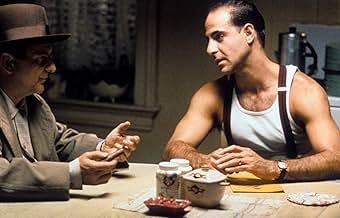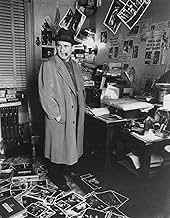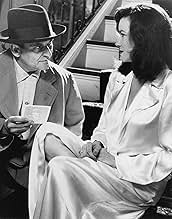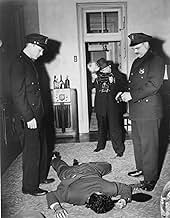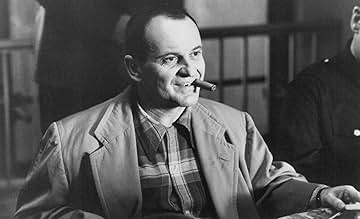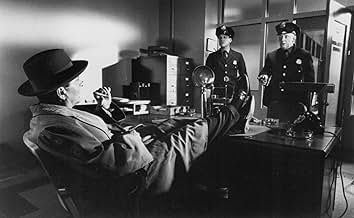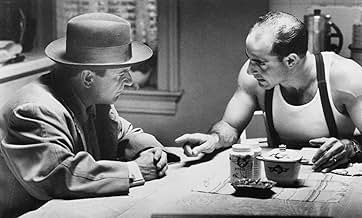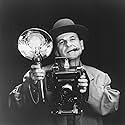PUNTUACIÓN EN IMDb
6,5/10
4,7 mil
TU PUNTUACIÓN
Relata la historia de un fotógrafo de los años 40 que se especializa en el crimen y no se involucra hasta este momento.Relata la historia de un fotógrafo de los años 40 que se especializa en el crimen y no se involucra hasta este momento.Relata la historia de un fotógrafo de los años 40 que se especializa en el crimen y no se involucra hasta este momento.
- Premios
- 1 nominación en total
Christian Stolte
- Ambulance Attendant
- (as Christian Stolti)
Gian-Carlo Scandiuzzi
- Maitre D' - Cafe Society
- (as Gian-Carlo Scanduzzi)
Reseñas destacadas
Joe Pesci plays the role of Leon "The Great Bernzini" Bernstein with accomplishment, as a kind of grubby, middle-aged everyman. Barbara Hershey, 44 when she made this movie, makes the screen sizzle by her mere presence as Kay Levitz. Pesci probably should have gotten an Oscar nomination for this performance, which is understated, sincere, and totally convincing. Some of the bit actors turn in good, solid performances with only a line or two.
The movie itself is heavy handed in spots, but director Franklin has written a number of movies and has a good ear for dialog. The mood of the piece is beautifully created and handled; camera work, lighting and music creating a real experience. The use of black and white sequences and inter-cutting of still photography is wonderfully handled. Maybe only a photographer can really appreciate the way Bernzini looks at the world as a photograph waiting to happen. People who are not willing to surrender to the experience of a movie will have less of a reaction to it.
The story is classic film noir, and more remarkable for being based on true events; blending together the great photographer Weegee (many of his photographs are actually used in the movie) and a gas-coupon scandal from the early days of American involvement in WWII. But, having said that, one misses the haunting quality this film conveys.
The movie itself is heavy handed in spots, but director Franklin has written a number of movies and has a good ear for dialog. The mood of the piece is beautifully created and handled; camera work, lighting and music creating a real experience. The use of black and white sequences and inter-cutting of still photography is wonderfully handled. Maybe only a photographer can really appreciate the way Bernzini looks at the world as a photograph waiting to happen. People who are not willing to surrender to the experience of a movie will have less of a reaction to it.
The story is classic film noir, and more remarkable for being based on true events; blending together the great photographer Weegee (many of his photographs are actually used in the movie) and a gas-coupon scandal from the early days of American involvement in WWII. But, having said that, one misses the haunting quality this film conveys.
This is a wonderful piece of work. The visual look of the movie is simply fantastic. But it should had been better if it was in black and white! In this case, Public Eye could be seen as a 1930's gangster movie. But the color of this movie looks like black and white. This film had anything I love about the Bogart, Robinson and Cagney movies. It's also give a chance to Joe Pesci to plays perhaps the role of his life. He's fabulous! Hard cigar smoking little guy ain't afraid of anything to have a good photography. He thinks big cities photos is art. He's also very moving, in the way Ernest Borgnine was in Marty, when he falls in love with wonderful Barbara Hershey. This is a great movie, one of the best American movie of the 1990's.
I've never rated this movie that high but I've gone back to it three times since it came out about 15 years ago on tape, so maybe I am underrating this. There still is no DVD of it, at least in Region I, and that's frustrating. There's something intriguing about this story that drives me back to it.
Perhaps that is so because it's about a photographer, something I did, too, while being in the newspaper business for years and an art form I've always enjoyed. The story also takes place in the 1940s and I love the style and atmosphere of that era which is beautifully shown here.
Joe Pesci is Leon Bernzini or "The Great Bernzini," a newspaper photographer and Barbara Hershey is a mysterious woman who Pesci has the hots for. There is a lot of mystery in here with Hershey's character. Pesci takes gruesome photos, doesn't get involved with anyone but he's willing to make an exception with "Kay Levitz" (Hershey)..... but is she good or bad for him?
Sad to say, the filmmakers kind of make a hero out of basically a sleazy guy who has few, if any, morals. ("Bernzy" was "paparazzi" before they invented the word!). The movie also has an unsatisfying ending, particularly with Hershey's character.
However, I keep getting drawn back into multiple viewings of this and I'd sure like to see what it looks like with a good DVD transfer.
Perhaps that is so because it's about a photographer, something I did, too, while being in the newspaper business for years and an art form I've always enjoyed. The story also takes place in the 1940s and I love the style and atmosphere of that era which is beautifully shown here.
Joe Pesci is Leon Bernzini or "The Great Bernzini," a newspaper photographer and Barbara Hershey is a mysterious woman who Pesci has the hots for. There is a lot of mystery in here with Hershey's character. Pesci takes gruesome photos, doesn't get involved with anyone but he's willing to make an exception with "Kay Levitz" (Hershey)..... but is she good or bad for him?
Sad to say, the filmmakers kind of make a hero out of basically a sleazy guy who has few, if any, morals. ("Bernzy" was "paparazzi" before they invented the word!). The movie also has an unsatisfying ending, particularly with Hershey's character.
However, I keep getting drawn back into multiple viewings of this and I'd sure like to see what it looks like with a good DVD transfer.
The Private Eye (1992)
This is a fictionalized story of the very real NYC crime photographer Weegee, and if you've seen pictures of Weegee or heard his story, Joe Pesci is the perfect cast for the role, coming right after "Goodfellas." He nails it, a terrific performance, even down to handling the cameras well.
Too bad the rest of the film is hit or miss. Maybe on the hit (good) side is the general set design and atmosphere. It feels like a slightly simplified and cleaned up 1942 Manhattan (where most or all of this occurs). And Barbara Hershey as the leading woman (not quite a femme fatale, it seems, but she has that look) is solid, especially with her hair up. You'll see, a good strong look. And the cameras are pretty right on (I'm a photographer, and I shoot with one of these 4x5 Graflex press cameras all the time), though at a glance it seemed that at least one of his Graflexes was a post-war model. We'll let that slip. And on the plus side it has to be said that Mark Isham's last minute hiring for the score was inspired, because it gives the movie the depth it needs.
The misses on the film are deeply integral to enjoying it all the way--the plot, the secondary actors, the direction. The latter is hard to pin down within the obvious and almost purposely clichéd plot, but you feel all along that the movie is put together functionally, as if the director knows most of all that these pieces have to go in order. But giving it flow, elegance, power, and even a convincing mise-en-scene is not just a matter of logic. It feels off, as it out of tune. It's especially noticeable because so much of the film is going right, including Pesci.
There is the question of why did they take Weegee (a.k.a. Arthur Fellig) and turn him into Bernzini (a.k.a. Leon Bernstein)--apparently it was a rights issue with the original story, but certainly the new story could have still been based on Weegee. The images in the film look like pseudo-Weegee moments as much as Pesci looks like Weegee, and Wikipedia says that some of these are actual Weegees. (I have my doubts, but who knows?) Both men had outrageous rubber stamps for the back of their prints that are almost identical--Weegee's said "Weegee the Great." The car is identical, for sure, and even the pace and the world are Weegee's.
Beyond all of this, the movie is entertaining if never commanding, and quite beautifully photographed--I'm talking the cinematography, now. My copy was VHS, and it doesn't sound like the DVD service through Amazon called the Universal Vault Series has very high standards (one user said it looked like VHS quality). I would think a full widescreen version would be worth the trouble--maybe try an Amazon instant play for $3. This says specifically that it is widescreen.
This is a fictionalized story of the very real NYC crime photographer Weegee, and if you've seen pictures of Weegee or heard his story, Joe Pesci is the perfect cast for the role, coming right after "Goodfellas." He nails it, a terrific performance, even down to handling the cameras well.
Too bad the rest of the film is hit or miss. Maybe on the hit (good) side is the general set design and atmosphere. It feels like a slightly simplified and cleaned up 1942 Manhattan (where most or all of this occurs). And Barbara Hershey as the leading woman (not quite a femme fatale, it seems, but she has that look) is solid, especially with her hair up. You'll see, a good strong look. And the cameras are pretty right on (I'm a photographer, and I shoot with one of these 4x5 Graflex press cameras all the time), though at a glance it seemed that at least one of his Graflexes was a post-war model. We'll let that slip. And on the plus side it has to be said that Mark Isham's last minute hiring for the score was inspired, because it gives the movie the depth it needs.
The misses on the film are deeply integral to enjoying it all the way--the plot, the secondary actors, the direction. The latter is hard to pin down within the obvious and almost purposely clichéd plot, but you feel all along that the movie is put together functionally, as if the director knows most of all that these pieces have to go in order. But giving it flow, elegance, power, and even a convincing mise-en-scene is not just a matter of logic. It feels off, as it out of tune. It's especially noticeable because so much of the film is going right, including Pesci.
There is the question of why did they take Weegee (a.k.a. Arthur Fellig) and turn him into Bernzini (a.k.a. Leon Bernstein)--apparently it was a rights issue with the original story, but certainly the new story could have still been based on Weegee. The images in the film look like pseudo-Weegee moments as much as Pesci looks like Weegee, and Wikipedia says that some of these are actual Weegees. (I have my doubts, but who knows?) Both men had outrageous rubber stamps for the back of their prints that are almost identical--Weegee's said "Weegee the Great." The car is identical, for sure, and even the pace and the world are Weegee's.
Beyond all of this, the movie is entertaining if never commanding, and quite beautifully photographed--I'm talking the cinematography, now. My copy was VHS, and it doesn't sound like the DVD service through Amazon called the Universal Vault Series has very high standards (one user said it looked like VHS quality). I would think a full widescreen version would be worth the trouble--maybe try an Amazon instant play for $3. This says specifically that it is widescreen.
I picked this up at the local grocery never having heard about it before, I thought it was a comedy, it is not. Joe Pesci scores one for the little guy that nobody likes in a big way. There is one confusing thing however. Was that Walter Winchell he was supposed to be friends with? That part confused me. There was also something said about the American mob families working with the Italian mob families to overthrow Italy in the movie era 1942. Was that true? Over all I really enjoyed it and for once could not predict the outcome. If you want something a little different, this is it.
¿Sabías que...?
- CuriosidadesIt took Howard Franklin 10 years before he could get his screenplay turned into a film.
- PifiasWhen Kay leafs through Bernstein' photo album, there is picture of a New York City taxi with a rectangular roof light which displays not only the word "Taxi" but also whether the taxi is off duty and its medallion number. Those signs did not come into service until the 1960s. In the 1940s, when the movie is set, New York City taxis used a variety of curved roof lights used in most other cities.
- Citas
Kay Levitz: It doesn't matter what people say unless you believe them.
- Banda sonoraYou Can't Say No to a Soldier
(1942)
Music by Harry Warren
Lyrics by Mack Gordon
Performed by Sammy Kaye and His Orchestra
Courtesy of Sandy Hook Records
Selecciones populares
Inicia sesión para calificar y añadir a tu lista para recibir recomendaciones personalizadas
- How long is The Public Eye?Con tecnología de Alexa
Detalles
Taquilla
- Presupuesto
- 15.000.000 US$ (estimación)
- Recaudación en Estados Unidos y Canadá
- 3.067.917 US$
- Fin de semana de estreno en EE. UU. y Canadá
- 1.139.825 US$
- 18 oct 1992
- Recaudación en todo el mundo
- 3.067.917 US$
- Duración1 hora 39 minutos
- Color
- Relación de aspecto
- 1.85 : 1
Contribuir a esta página
Sugerir un cambio o añadir el contenido que falta

Principal laguna de datos
By what name was El ojo público (1992) officially released in Canada in English?
Responde

